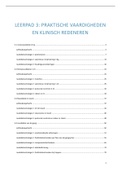Summary
Samenvatting Revalidatie bij neurologische aandoeningen: praktijk
- Course
- Institution
3e bach Revalidatiewetenschappen en kinesitherapie Uhasselt Samenvatting slides/powerpoints en blokwijzer sofia Revalidatie bij neurologische aandoeningen: praktijk (leerpad 3)
[Show more]



